| On The Virtues
of the Fuselage-Frame Skin Boat
Full disclosure: The plans for Egret, a fuselage-style
skin-on-frame kayak of my own design, are available
from Duckworks.
One might therefore be inclined to think that this
article is entirely self-promotional, and that I’m
just singing the praises of the fuselage frame because
I design kayaks this way, but that is not accurate.
The article is only partly self-promotional, and I
really believe what I say about fuselage frames, otherwise
I wouldn’t design them this way.
The word “fuselage” is from the French
for “spindle-shaped” and is an aircraft
term. Its use to describe a method of skin kayak construction
may be more recent than the method itself, but it’s
helpful in that it differentiates the type from boats
built in the traditional arctic style. The similarities
between boat and aircraft construction are apparent,
and we know which came first. Boats had frames and
longitudinal timbers (and were covered in skins) long
before aircraft were a gleam in Leonardo DaVinci’s
eyes, and even the earliest non-log boats mimicked
the spine, ribs and skins of endoskeletal animals.
The basic methods are old.
Modern fuselage-style skin kayak construction came
into being with the availability of sheet plywood,
which made the getting out of frames a much easier
matter. Rather than construct a five- or six-sided
frame out of as many pieces of wood, each could be
cut out of the plywood in one piece, simplifying matters
immensely. Percy Blandford’s designs were early
examples, and the method had its heyday in the 1950s
and 60s, when my dad and many others ordered plans
and kits from Popular Mechanics.
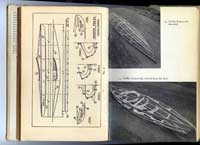 |
Percy Blandford’s
designs were early examples of modern fuselage-style
skin kayak construction. |
Somehow the method has languished in the intervening
decades. A couple of venerable plans catalogs still
stock vintage skin kayaks, but there are only two
contemporary designs other than my own that I know
of. This is unfortunate in the large view of things,
but on the other hand it affords me the opportunity
(full disclosure again) to scuttle, like an opportunistic
hermit crab, into this unoccupied niche and wave my
flag.
I do not exaggerate when I say that a fuselage-frame
skin boat is the cheapest and easiest way to build
your own kayak. Materials for a basic Egret are less
than $300, much less expensive than plywood or strip-built
kayaks. All wood can be purchased at a lumberyard,
and even if the builder elects to use okoume ply for
the frames, the cost remains within this parameter.
Heat-shrink Dacron is less than $4/yard. Even the
addition of Xynole polyester fabric and epoxy, if
one prefers a laminated skin, does not send the bill
through the roof.
| I do not exaggerate
when I say that a fuselage-frame skin boat is
the cheapest and easiest way to build your own
kayak. |
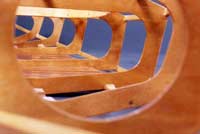
|
Building a fuselage-style frame is about as easy
as boatbuilding gets. The building jig can be as simple
as a straight 2x6, although the instruction book included
with Egret’s plans shows how to make a plywood
box-beam strongback. The keel is a length of 3/4”
x 1” wood, slotted at either end for the stem
and stern pieces. The frames and bulkheads are easily
cut out using the full-size patterns, then are positioned
on simple uprights and glued to the keel. Stringers
are bent around the frames, glued and screwed to the
stem and stern and also glued to the frames. The bends
are gentle and do not require steaming. Not much to
it, is there? After that, there is the cockpit opening.
Two thin laminates are bent into an oval for the cockpit
carlins. Some steaming is best here, but that can
be accomplished by wrapping the wood in towels and
saturating with boiling water. No need to build any
elaborate steam-box contraption.
 |
For the cockpit opening, two
thin laminates are bent into an oval for the
cockpit carlins. |
Egret is not just a rerun of mid-20th-century fuselage-style
kayaks, though. The filleted epoxy joints at the intersection
of every frame and longitudinal permit the use of
thinner plywood and stringers than are found on older
skin boats.
| The filleted epoxy joints at
the intersection of every frame and longitudinal
permit the use of thinner plywood and stringers
than are found on older skin boats. |
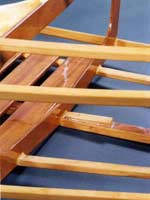
|
1/2 inch ply was the standard in the 50s and 60s,
but Egret does just fine with 1/4 inch (6mm). That’s
a significant saving of weight, and thinner frames
permit some flexing while retaining the box-like strength
of the glued joints. One can wiggle the end of a naked
Egret frame as it sits on sawhorses and wonder if
it’s too flexible, but once the skin is attached
and shrunk taut, everything is brought into balance.
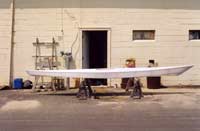 |
Once the skin
is attached and shrunk taut, everything is brought
into balance. |
Heat-shrink Dacron is a modern miracle. Anyone who
has wrestled with #10 duck canvas and copper tacks
will appreciate how easily Dacron attaches to the
frame. The fabric is draped over the frame, then pinned
and slit at the ends. The appropriate contact cement
is applied to the stem, stern and to the sheer stringers,
and the fabric is attached. There is none of the hassle
of chasing wrinkles by pulling and repositioning tacks,
as is the case with a canvas skin. Dacron is a lighter
and more pliable fabric, and any minor wrinkles flatten
out when it is shrunk with a common household iron.
Neither canvas nor other synthetic fabrics have the
shrinking capacity of aircraft Dacron, and they are
much harder to work with.
| Anyone who has wrestled
with #10 duck canvas and copper tacks will appreciate
how easily Dacron attaches to the frame. |
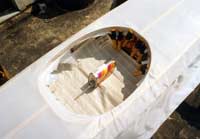
|
The addition of a layer of Xynole polyester and epoxy
over the Dacron skin is yet another example of how
modern materials improve the genre. An outer layer
of Xynole adds a bit of weight, but increases the
strength of the skin considerably and provides a high
degree of finish. Sometimes it’s hard to tell
it’s a skin boat because of the smooth, faired
surface. Xynole is known for its abrasion resistance,
and I suspect it would be hard to rip this composite
skin with anything short of a sharpened narwhal tusk.
Hypalon, used to coat inflatables and river rafts,
is another high-strength way to augment the already
tough Dacron.
Put all these innovations together and the fuselage-frame
skin kayak becomes a new creature. I’d call
it a kayak for the 21st century, but that would be
trite. I’d call it a young athlete compared
to an old sack of bones, but that would be unfair
to your father’s skin boat, which, after all,
was a lot of fun. Let’s just say that we have
new ways of doing a fine old thing.

Other articles about skin-on-frame
kayaks:

|